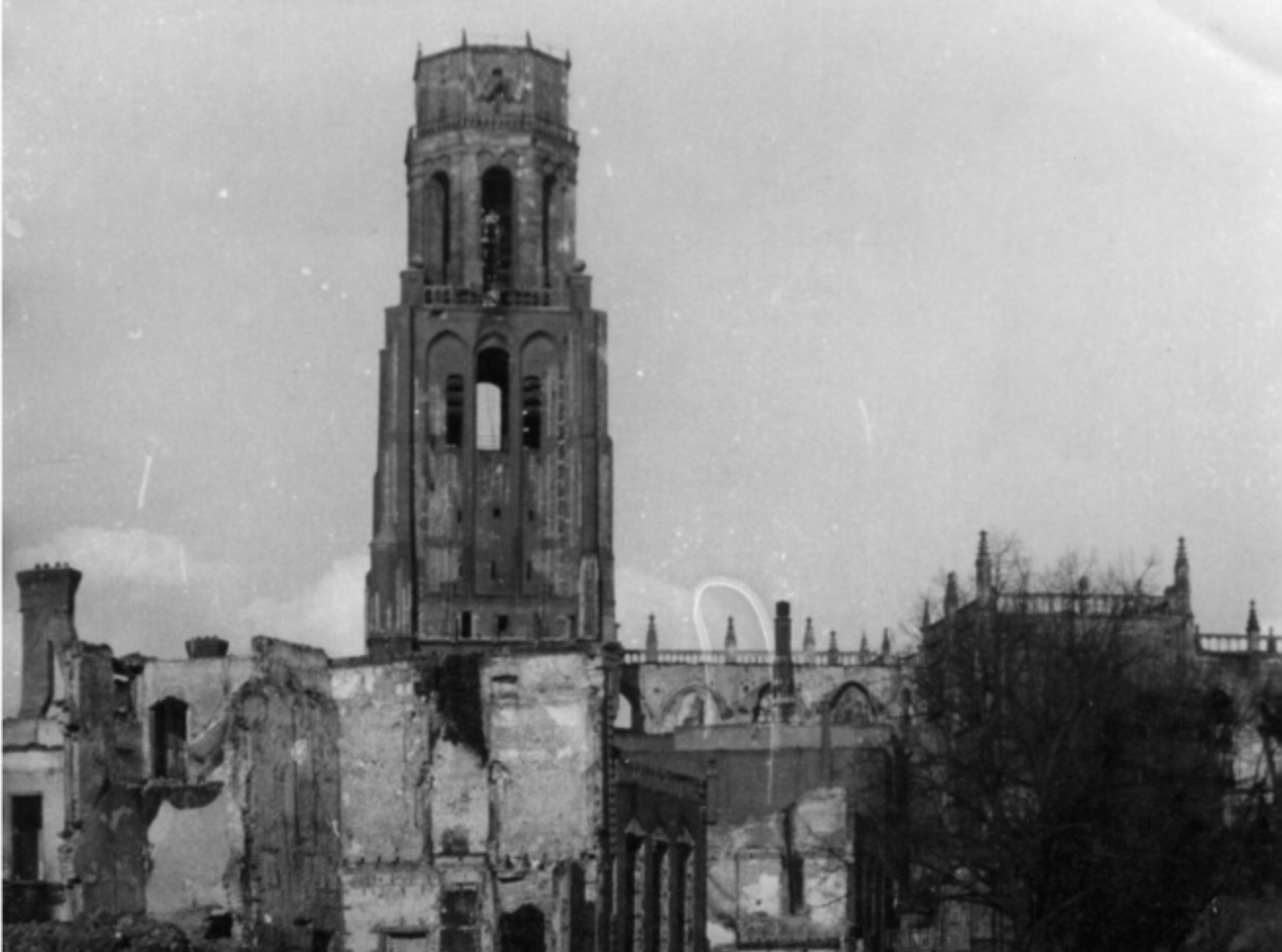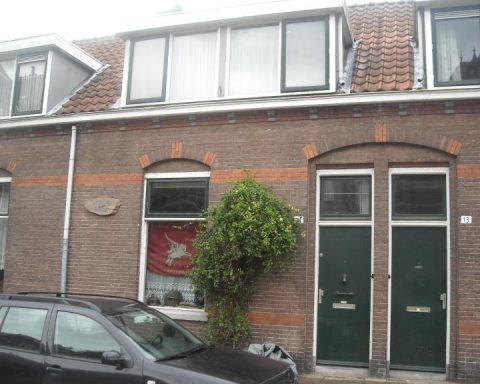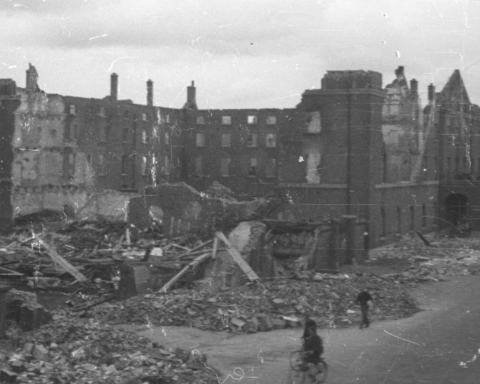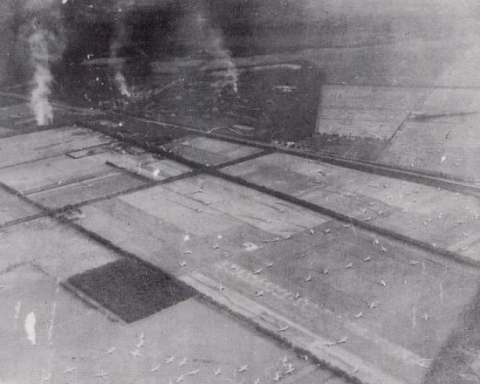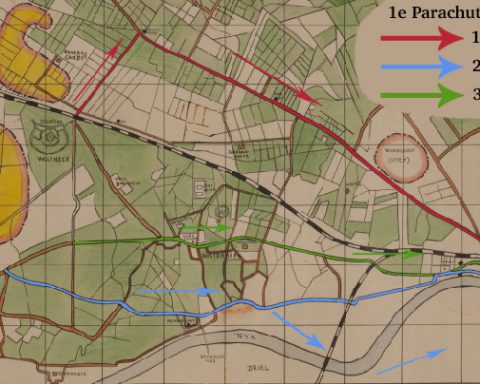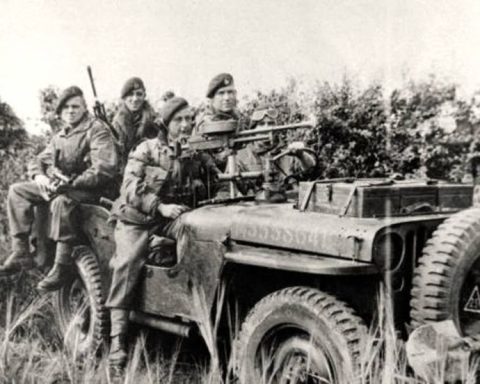The Eusebius Church was virtually destroyed during the bombing of the Rhine Bridge on October 7, 1944. But the church already suffered extensive damage during the Battle of Arnhem. As a result of German shelling on the church, the Eusebius caught fire on Wednesday, September 20.
The spire and roof of the church burned down completely due to the shelling on Wednesday, September 20.
During the Battle of Arnhem, both the British troops at the Rhine Bridge and the German troops gathered around the British defensive position suspected that an observation post had been set up in the church tower by enemy troops that passed on information about enemy troops.
In reality, there were no soldiers in the church at the start of the fighting. But there were people in the Eusebius from the evening of Sunday, September 17. There were volunteers from the Air Protection Service on both the roof and in the tower of the church.
The most important task of the Air Protection Service was to sound the air raid sirens in the event of an aircraft attack. The high church was an ideal place to scan the sky for bombers.
However, the helmeted volunteers of the Air Protection Service were seen by British and German soldiers in the early morning of September 18, according to the report that team commander W. Bozelie wrote after the Battle of Arnhem.
And that report shows that the Dutch in the church were seen as an enemy lookout post by both the warring parties.
“On Monday morning at about six o’clock the tower and the church roof were taken under heavy machine gun fire by the English from the bridge, followed later by artillery from an armored car. Presumably caused by carelessness of the lookout service men, who were wearing helmets and looking out behind walls. At great risk to their lives, all the men whom I had dispersed over the church roof and tower managed to get to relative safety in the tower.”
Because both the British and the Germans fired at the church tower with machine guns and artillery, the tower was shot at from both the south and the east. Nevertheless, the men of the Air Protection Service remained at their posts.
But on Tuesday afternoon, September 19, Bozelie deemed the situation in the church too dangerous. The shelling by the English and Germans continued unabated and Bozelie was afraid that there would be casualties.
“When leaving the church and tower we went to the main post and were chased away from there by German soldiers after a few hours.”
Bozelie also mentions in his report that German soldiers laid telephone cables in the church and the tower and formed lookout posts that afternoon.
Friendly fire
On Wednesday morning, September 20, these German lookouts shot from the church tower at the soldiers they saw walking in the vicinity of the Rhine Bridge. They hit three German soldiers, including SS-Sturmbannführer Hans-Georg Sonnenstuhl.
Sonnenstuhl was slightly wounded in the leg and concluded that there were “enemy submachine gunners” in the church. He therefore ordered an incendiary grenade to be fired at the tower from a cannon: “Shooting, detonation, spray fountains. There was no more shooting from the church tower,” Sonnenstuhl wrote happily in his battle report.
The German soldiers in the Eusebius Tower probably died as a result of this shelling. However, the German incendiary grenade also caught fire in the Eusebius Church. First the wooden spire. Then also the roof above the church nave.
British sapper Tom Carpenter wrote after the war: “The tower of the Grote Kerk was busy on Wednesday afternoon. I had no idea how extensive the damage was to the church, but it must have been significant.”
Prisoners of war
The still smoldering church was used by the Germans on Thursday, September 21, to collect the British who had been taken prisoner of war at the bridge. On Wednesday evening, September 20, the British soldiers who had defended the Rhine Bridge had to give up their positions.
The exhausted soldiers from John Frost’s battalion had tried to reach Oosterbeek through a major breakout, but almost all British airborne soldiers were taken prisoner in the city center of Arnhem.
In total, about 200 British soldiers were gathered in the Eusebius Church. There was rubble everywhere in the church and every now and then some debris fell from the roof. But most soldiers didn’t care, as Major Tony Hibbert wrote after the war:
“Almost everyone took the opportunity to make up for the lack of sleep we had experienced over the past four days.”
Destruction
The church was further damaged during the bombing of the Rhine Bridge by the Allies on October 6 and 7, 1944. Many bombs missed their target during those bombings. The Eusebius Church was virtually destroyed by a few direct hits.
Yet even then the badly damaged Eusebius Tower was still standing. The final blow for the church tower came in January 1945 when the Germans further destroyed the already destroyed Rhine Bridge by means of an explosion.
The pressure wave from this explosion was too much for the tower, which collapsed with a thunderous noise.

